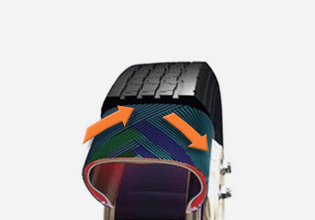Types of Tyres
2023-08-28 16:24:46
Bia Tyre
Bias tyres are used primarily for off-the-road, agricultural, and industrial vehicles.
A bias-ply tyre, also known as a bias tyre, has a distinctive internal structure that sets it apart from other tyre types, such as radial tyres. The key components of a bias tyre's structure include:
Carcass: The carcass is the innermost layer of the tyre and serves as the tyre's foundation. It consists of multiple layers of fabric cords, typically made of nylon, polyester, or other materials, that run diagonally across the tyre from bead to bead. These cords are positioned at alternating angles, forming a crisscross or bias-ply pattern.
Beads: The beads are the tyre's innermost edges that seat against the rim. They are made of high-strength steel wires coated in brass or other anti-corrosion materials. The beads provide the necessary stiffness to keep the tyre securely mounted on the wheel.
Belt: Some bias-ply tyres may have a belt, but it is not a standard feature in this type of tyre. If a bias tyre does have a belt, it typically consists of one or more layers of fabric cords, often made of nylon, positioned under the tread area. The belt helps improve the tyre's stability, handling, and resistance to punctures.
Tread: The tread is the outermost layer of the tyre that comes into direct contact with the road surface. It is made of a durable rubber compound designed to provide traction, wear resistance, and grip in various road conditions. The tread pattern varies based on the tyre's intended use, such as all-season, winter, or off-road.
Sidewall: The sidewall is the area of the tyre that connects the bead to the tread. It contains important information about the tyre, including its size, load rating, speed rating, and manufacturer's branding. Sidewalls can also have raised lettering or decorative features.
In a bias tyre, the cords in the carcass run at an angle to the direction of travel, typically at around 40 degrees to the road surface. This bias-ply construction provides certain advantages, such as good puncture resistance and load-carrying capacity. However, bias-ply tyres tend to have a stiffer ride and generate more heat during operation compared to radial tyres, which have cords running perpendicular to the direction of travel.
Radial Tyres

Radial tyres are produced for passenger cars, light trucks and buses.
A radial tyre, also known as a radial-ply tyre, is a type of tyre with a specific internal structure that sets it apart from bias-ply tyres. In a radial tyre:
Carcass: The carcass is the innermost layer of the tyre and forms the tyre's foundation. In radial tyres, the carcass cords are typically made of steel and are arranged in a radial direction, meaning they run perpendicular to the tyre's circumference (i.e., they point straight out from the center of the tyre). This radial arrangement of cords provides the tyre with certain advantages.
Belts: Most radial tyres feature one or more layers of steel belts located just below the tread area. These steel belts provide added strength and stability to the tyre, contributing to improved handling, tread life, and resistance to punctures.
Tread: The tread is the outermost layer of the tyre that comes into contact with the road surface. It is made of a specialized rubber compound designed to provide traction, wear resistance, and grip in various road conditions. The tread pattern varies based on the tyre's intended use, such as all-season, winter, or high-performance.
Beads: The beads are the tyre's inner edges that sit on the wheel rim. They are typically made of steel wires coated with anti-corrosion materials, providing the tyre with the necessary stiffness to stay securely mounted on the wheel.
Radial tyres offer several advantages over bias-ply tyres, including:
Lower Flatness Ratio: Radial tyres have a lower flatness ratio compared to bias-ply tyres, meaning the tyre's sidewalls have a more upright position. This contributes to a smoother and more comfortable ride.
Enhanced Performance: Radial tyres generally offer better performance characteristics, including improved traction, handling, and stability. They provide excellent grip during acceleration, cornering, and braking.
Fuel Efficiency: Radial tyres generate less heat during operation, leading to reduced rolling resistance. This, in turn, can improve fuel efficiency.
Safety: The superior performance characteristics of radial tyres, such as their ability to maintain grip even during high-speed travel and emergency maneuvers, make them a safer choice for modern vehicles.








